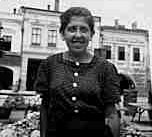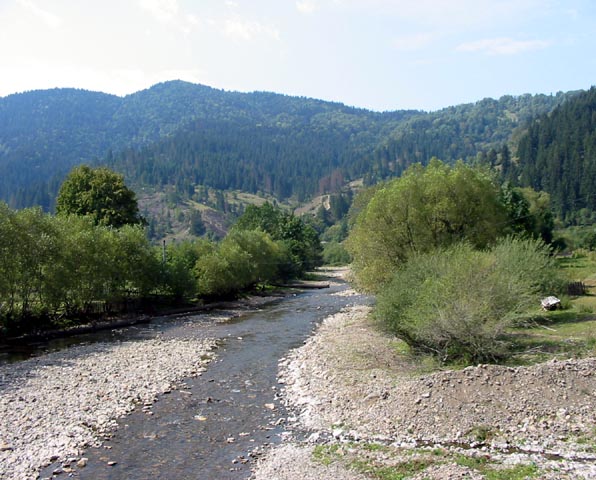

Vishni Bystra is a small, isolated rural community in a beautiful setting of pine forests, mountains, and mineral springs. It is in the Carpathian Mountains in what is now Ukraine but historically was part of the Austro-Hungarian empire, Czechoslovakia, Hungary, and the Soviet Union. Before the Second World War it was home to several thousand inhabitants, among them around one hundred ultra-orthodox Jewish families. No Jews live there now. Of the 100,000 Jews who lived in the Carpathians prior to the Second World War, it is estimated that only 10% survived. My mother, Etta Freilich Wandrei, and my aunt, Pnina Fixler Lesser, were two of the lucky ones.
 |
 |
| My mother, Etta Freilich Wandrei | My aunt, Pnina Fixler Lesser |
A village in northern Carpatorus [the Carpathians], Ukraine Vysny Bistre is located near the villages of Majdan and Torun. Most of the residents are Ruthens [Ukrainians].
Until 1918 the area belonged to the Marmores district, Hungary and since then until 1939 to the Republic of Czechoslovakia. During World War II it was under Hungarian occupation, and in 1945, after the war, it was annexed to the Ukraine, then a republic of the U.S.S.R.
There are no accurate sources as to the number of Jews in the village, as the inhabitants of Vysny Bistre were usually registered as residents of Majdan. However the Jews of the village formed their own community, which was not part of the Jewish community of Majdan.
Both communities belonged to the rabbinate of Volove. According to one source, in 1830 there were 20 Jews living in Vysny Bistre. According to testimonies of local Holocaust survivors, between the two world wars there were about 60 Jewish families living there, about 200 Jews. The Jewish community had a synagogue, a Mikve (ritual bath) and a cemetery. The synagogue also served as a Beth Midrash [house of learning]. Between the two world wars the Shohet (ritual slaughterer) Haim BR Meshulam Friedman distinguished himself in the community.
Most of the Jews of Vysny Bistre were Dolina, Zydaczow and Spinka Hassidim, and some were Vizhnitz, Sighet and Belz Hassidim. Many were descendents of the Weizer and Hoifman families.

Site of the Synagogue and Czech School
For another description of the history of Bistra see its listing in the Maramures Yizkor book . For a description of the history and current status of the cemetery, see Verkhnyaya Bystra.Following the Munich Agreement of 1938, the republic of Czechoslovakia ceased to exist. In November 1938 a Ruthenian autonomy was founded in the area, which was cancelled when Hungary, an ally of Nazi Germany, occupied the area in March 1939. Following the discriminating laws of the Hungarian authorities, Jews were no more allowed to trade, or to own workshops. Many were left with no means of livelihood. In the summer of 1941 all Jews who did not have Hungarian citizenship were deported from Vysny Bistre. Most of them were murdered outside the city of Kamenets Podolsk in the Ukraine. On March 19th 1944 the Germans entered Hungary. The remaining Jews of Vysny Bistre were deported on April 25th to a ghetto in the village of Iza, near the city of Chust. At the end of May they were sent to the death camp in Auschwitz.
Old Jewish cemetery
After the Holocaust there was no organized Jewish community in Vysny Bistre, and no Jews [have lived] there since the 1970's. (used with permission from Beth Hatefutsoth - the Nahum Goldmann Museum of the Jewish Diaspora, Tel Aviv, Israel)
Would you like to connect with others researching Vishni Bystra?Click the button to search the JewishGen Family Finder database.
|
Updated by KW December 29, 2009 Copyright © 2003 Karin Wandrei |
This site is hosted at no cost by JewishGen, Inc., the Home of Jewish Genealogy. If you have been aided in your research by this site and wish to further our mission of preserving our history for future generations, your JewishGen-erosity is greatly appreciated.